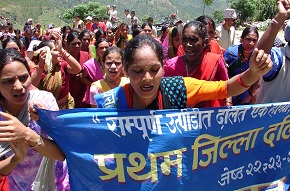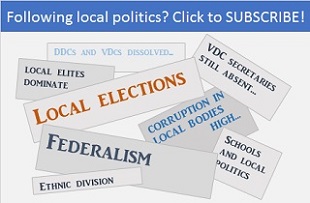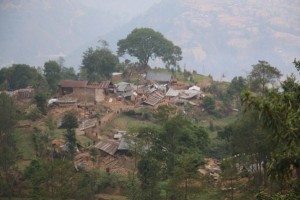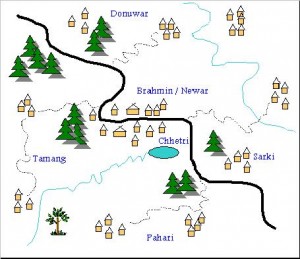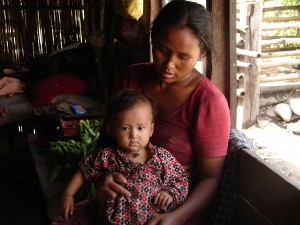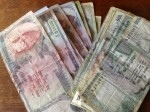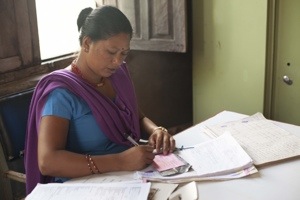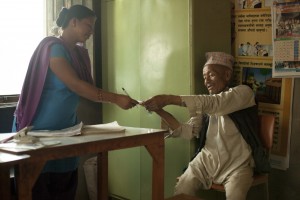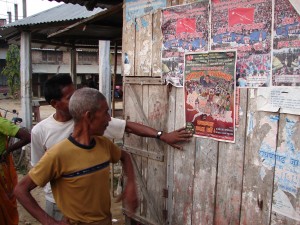Welcome to the theme!
The last local election was in 1997! That say’s a thing or two about local politics, doesn’t it? Sure, from one angle, local politics might seem rather insignificant when the powers in Kathmandu don’t even bother to reconstitute the country’s elected local bodies. But on the other hand, one might wonder: why don’t they care to hold the local elections? We can only speculate, and so we do on this page. But there are also facts, news and much more! Get “Local politics” updates here…
What’s New!?
Local elections: a ride of optimism and back again
Without relief in sight: locals depend on self-help
A never-ending story: postponing the local elections.
New survey: almost 75 percent reject federalism.
Crash course on local politics in Nepal.
Corruption: a pretext to stall local elections?
mnbmnbmnb
Local elections: a ride of optimism and back again
Local elections are a major priority area in 2015-16: President Yadav delivering his policy speech in parliament
It was a turbulent week in the “life” of local elections in Nepal last month – as it’s been several times before. On July 8 President Ram Baran Yadav presented the government’s policy programme in parliament for the next fiscal year – 2015-16 – and made clear that “local polls” are a major priority area. In fact, the reconstitution of elected local bodies – dissolved since 2002 – is a prerequisite, the President made clear, to an efficient reconstruction process in the earthquake-affected districts. So, for those eager to again see elected local politicians coming to power, this was a major cause of optimism! More…
Without relief in sight: locals depend on self-help
Chief District Officer of Sindhupalchowk, Krishna Prasad Gyawali, just abandoned his post. It’s not “dereliction of duty”, he explains, but a call for help! On Wednesday, four days into the earthquake aftermath, one of the worst hit districts had still not received the most basic relief aid – like tents, food and medicine supplies. Thousands of locals are without homes, many have lost their food granaries, and all Gyawali could tell them was: “I can’t help you – come back later”. Scores of villagers who just lost everything started protesting, and now Gyawali refuses to return until the government delivers. More…
A “never ending story”: postponing the local elections
It has not really mattered who formed the government, or who was prime minister. Since 2002, when local elections were first due – five years after the 1997 election for the country’s DDCs, VDCs and municipalities – local elections have been postponed as persistently as has the finalisation of the constitution. Official reason? Anything from king Gyenendra’s take-over and the Maoist conflict to growing local corruption and a need to adopt the constitution first. The Election Commission has declared itself ready to organise the election many times. But every time, the government has postponed. Want to recount the recent chapters in this “never ending story”? Check out this overview!New survey: almost 75 percent reject federalism
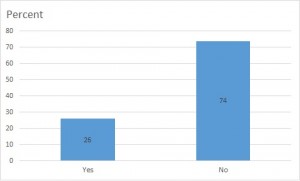 Federalism has been on everybody’s lips for seven-eight years. A federal state structure – based on ethnicity – was indeed a popular idea back in 2008. But what about now? Well, ask the Kathmandu-based Interdisciplinary Analysts (IA), and they’ll say it’s all changed. Merely 26 percent of the population are in favour of federalism; and even more so, out of this segment only 12 percent favours federalism based on ethnicity!
Federalism has been on everybody’s lips for seven-eight years. A federal state structure – based on ethnicity – was indeed a popular idea back in 2008. But what about now? Well, ask the Kathmandu-based Interdisciplinary Analysts (IA), and they’ll say it’s all changed. Merely 26 percent of the population are in favour of federalism; and even more so, out of this segment only 12 percent favours federalism based on ethnicity!
IA’s results are based on a nation-wide survey among 3000 respondents. So it seems quite reliable too, statistically speaking. On top of that, another recent survey by Himalmedia supports these results. In fact, this week featured several arguments in the media against (ethnic) federalism. David Seddon wrote under the headline, “Devolution without federalism”, that now it’s time to return to the Local Self-governance Act of 1999 and start from there. That might not happen. But for the time being, a large majority of Nepalis do seem to favour the old set-up of elected local bodies.
Crash Course on Local Politics in Nepal
New to the local politics theme – to local government, local parties, and all the stuff that goes on in and around them? Check out our “Crash Course on Local Politics in Nepal”. It’s based on several years of research and field observations of local politicians in action – surrounded as they are with everything from bureaucrats and contractors to NGOs and user committees. Or if you know a lot already, do add comments to make it even better. It’s a short and concise text with plenty of illustrations. Enjoy! Go to crash course on local politics now.“Your crash course on local politics in Nepal is an extensive and well-researched brief for those coming into Nepal in need of a primer.” Christina Costello, Program Manager, Asia, NDI
Ethnic federalism or…?
The debate on “ethnic federalism” roars on! Any solution in sight? Well, it looks like a deadlock. Even worse, the demand for ethnic federal states seems a sure way to stall the constitution writing process. The deadline for completing the constitution is two months ahead and the parties just can’t agree! Here’s an op-ed from Rising Nepal on the topic – ethnicity is a huge stumbling block, writes Ritu Raj Subedi, but the parties should forget about it: ethnicity should not define the borders of federal states, Subedi argues. Agree or not, here are his thoughts:“Bodde, Hacchethu and Ethnic Federalism”.
kjk
Ethnic federal states: would it even work in a VDC?
Who is in favour of ethnic division in Nepal? Not so many as just five-ten years ago, at least not officially. We think that’s great news! Division of the territory into ethnic local governments would not even work within a VDC – the smallest entity. Go to almost any VDC and the diversity in terms of caste and ethnicity is big, in some cases counting dozens of different ethnic and caste communities. How power were to be devolved on the basis of ethnic or caste majority has puzzled us a great deal. Would it not just spark division and conflict, causing more problems for ordinary people – as though, say, resource scarcity, unemployment and poor public services were not enough? Well, of course opinions differ, but here’s our five cents on that.“Federalism and local elections are not contradictory, they are two sides of the same coin.” Damakant Jayshi – arguing that a constitution with a finalized federal structure is not a prerequisite for local elections to be held. Read his article in Nepali Times here…
Corruption as a pretext to stall local elections?
In 2011-12 the notion came up that local parties and politicians had become “too corrupt” to serve in any capacity of local government. Give them power over the use of scarce resources and all will go to waste, high-level people claimed. Indeed, the Minister of Local Development agreed to a CIAA recommendation to dissolve the last remnants of DDCs, VDCs and Municipalities: the so-called multiparty commitees comprised of the main parties also represented in the Constitutional Assembly (CA). But would local politicians actually be more “corrupt” than their colleagues at the central level? Or would the talk about corruption just be a pretext? We’ve uploaded a post speculating about this question – read it here…A bit about work as assistant VDC secretary
What’s it like to be a staffer at the lowest level of government: in a VDC? Many VDC secretaries will tell you it’s not the greatest job in the world. Pick any point in time over the last decade or so and you’ll find quite a lot of VDC secretaries absent. Many posts are often vacant too! But there are exceptions, and we recently ran into one of them: Indramaya from Palanchowk out in Kavre.
Indramaya is not even a VDC secretary but only “assistant secretary”, a post created some time back. The DDC realised that several VDC secretaries were in fact over-burdened – they had to look after two, sometimes even three VDCs at a time – so it was decided to recruit assistant secretaries: one per VDC. The condition was that all had to be women, married to ensure they wouldn’t leave.So, what does an assistant VDC secretary do? Well, quite a lot: “It’s a bigger responsibility than I thought”, Indramaya explains. “The villagers come here and I have to attend to all their matters”. More…
140 – a number to wonder about
The aspect of Nepali party politics that caught our attention last month is a simple one at first glance: the number of parties that registered for the – maybe – upcoming election in November this fall. Aside from the number, however, there is little simple about it. 140 is the count of political parties right now, excluding those that decided not to participate. A huge number! It might not be surprising that the number has climbed that high – perhaps it’s only natural that more parties are formed as time goes by. But then again: how can there be so many parties – in Nepal?
Ask a scholar and many will say that political parties are meant to represent sets of values and goals in society: interests that many people have in common. That’s their classical role. The old social-democratic parties of Europe, for instance, represented the interests of the “working class”, conservative parties those of the better to do, still others different segments. Many envisage that parties and their leaders should represent broader ideologies and policy goals. So, if that’s the role of political parties, what interests do each of the 140 parties in Nepal’s election represent: those of the “working class”, perhaps, or of the “farmers” or the “middle class”? More…

